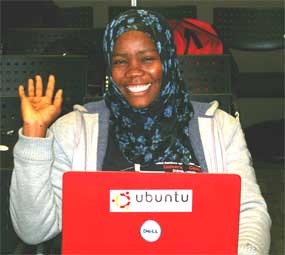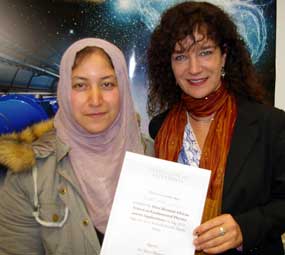The First African School on Fundamental Physics and its Applications (ASP2010)
Christine Darve on behalf of the ASP2010 Organizing Committee

ASP2010 students and lecturers during the week dedicated to Accelerators and other HEP Applications
The first School on Fundamental Physics and its Applications, ASP2010, took place in Stellenbosch, South Africa, from August 1st to 21st, 2010, with the general aim of fostering science in Africa.
The aim and mission of this biennial school is unique. The “raison d’être” is to build the capacity to harvest, interpret, and exploit the results of current and future physics experiments with particle accelerators and to increase proficiency in related applications and technologies. Based on those principles, a small group of scientists organized this first ASP school including Bobby Acharya (ICTP), Ketevi Assamagan (BNL, USA), Christine Darve (FNAL, USA), John Ellis (CERN) and Steve Muanza (CNRS-IN2P3, F).
Following a selection process, 65 students from various backgrounds and education levels were invited to participate. 10 students came from South Africa and another 50 students came from 17 other African countries. 5 other students from Canada, Germany, Switzerland, the USA and India, also attended helping to create a melting pot of cultural diversity. African students were fully supported financially to attend the intensive three-week school. 16% of the students were women. Approximately 40 devoted and motivated lecturers, tutors and organizers came from around the world and from the local physics community. Most of our prestigious lecturers’ institutions supported their travel costs.
The school was based on a close interplay between theoretical, experimental, and applied physics. It covered a wide variety of topics: particle physics, particle detectors, astro-particle physics and cosmology, computing, accelerator technologies and some applications, such as medical physics, synchrotron radiation, light sources, and magnetic confinement fusion.
The three-week school had a heavy packed agenda. Typically, class days consisted of four academic lectures of 45 minutes followed by three hours of discussion and/or practical sessions. Discussion and exercises were organized by the lecturers to motivate student participation. Laboratory sessions were organized to give the students “hands-on” scientific training, e.g. students became acquainted with the use of scintillation detectors and performed measurements of environmental radioactivity at the iThemba Laboratory for Accelerator Based Sciences (iThemba LABS). Laser practicals and a computing tutorial for simulations using the GEANT4 toolkit were also available at the University of Stellenbosch. Our students, appreciated the opportunity to communicate and learn directly from senior scientists.
To complement the fundamental physics classes, ASP2010 emphasized the role of high-energy physics in medicine, computing and other areas of technology through the "applications" aspect of the program. The proximity of iThemba LABS, situated between Cape Town and Stellenbosch, played a key role in organizing the school. As well as being an important producer of radioisotopes, it is the only laboratory in the southern hemisphere where hadron therapy is performed with neutron and proton beams.
To highlight established research in fundamental physics in South African universities and research institutes, several high-profile South African scientists and government officials participated in the last day of the school, including Daniel Adams, Chief Director: Emerging Research Areas & Infrastructure – Human Capital and Knowledge Systems at the South African Department of Science and Technology. This outreach and forum day reviewed the practical aspects of fundamental physics, which could be used as a gateway to innovation and to enhance future collaborations. Many institutes were supportive of our effort. Emmanuel Tsesmelis, adviser to the CERN Director General stated “CERN provides a gateway to forefront science through innovation and by bringing the world together at this rainbow high-energy physics laboratory through global collaboration. CERN looks forward to strengthening ties with Africa and to discovering and sharing the new science of the 21st century together through Ubuntu”. (Ubuntu is an ethical concept of African origin and is also the name of a Linux-based operating system.)
In addition to academic lectures, a video-conference with Young-Kee Kim, Fermilab’s Deputy Director, provided a vision of science on a planetary scale; a webcast that connected the students to the CERN Control Centre enabled them to experience a live demonstration of proton acceleration; and special talks by John Ellis, Albert de Roeck and Philippe Lebrun from CERN, and Jim Gates, from the University of Maryland (a scientific advisor to President Obama), also made big impacts on the students.
This project was possible thanks to the support of 15 different national and international organizations and institutes1 . Generous logistical support came from CERN, As CERN’s director-general, Rolf Heuer, pointed out, "What this school has brought home very clearly is that there is the talent and the will in Africa to engage in advanced scientific education, and indeed with fundamental physics in general.”
The motivation and enthusiasm of the students, who symbolize the future of fundamental physics and its applications in Africa, made our efforts worthwhile. One of our goals was to insure that the demanding school program and the diversity of the student’s backgrounds could fuse harmoniously. During the school the students, lecturers and organizers shared the same dynamism allowing everybody to build durable networks in a physics world without borders. Lecturers and organizers have continued to guide the ASP2010 students. For example, Giorgio Margaritondo, Solid-state physics Professor at EPFL, is organizing the hosting of African students in his University and Young-Kee Kim will welcome three students to participate in the Fermilab high-energy physics program. As she points out, “lifting the lamp beside the golden door to talented African and Latin American students is the spirit of what we are building in our laboratory.”
“This new series of schools will strengthen existing collaborations and develop current and new networks involving African physicists,” explained Fernando Quevedo, director of the Abdus Salam International Centre for Theoretical Physics (ICTP) in Trieste, one of the sponsors of the school. “This activity was a big success in all respects: lecturers of the highest scientific level, a perfect example of close collaboration among several international institutions towards a single goal and, most importantly, bringing the excitement and importance of the study of basic sciences to a community with great potential. The standard set for future activities is very high.”
Chilufya Mwewa, a participant from Zambia, summarizes what the school meant for her: “Attending ASP2010 was such an extraordinary opportunity that it had a huge positive impact on my life. The school indeed enhanced my future career in physics. Thanks to you and other organizers for opening us up to other physics platforms that we never had a chance to know about in our own countries.” Ermias Abebe Kassaye, a student from Ethiopia, echoed her thoughts: “I have got a lot of knowledge and experience from the school. The school guides me to my future career. I obtained the necessary input to disseminate the field to my country and encourage others to do research in this field. I am working strongly to achieve my desire and to shine like a star, and your cooperation and help is very essential to our success.” A complete report of the ASP2010 is available from our web site at http://AfricanSchoolofPhysics.web.cern.ch.
It is proposed to hold the second school in Ghana in 2012 and we welcome support for it! The enthusiasm of the students and the supporting institutions at ASP2010 were inspirational and give promise for the success of future international programs, collaborations and exchanges.

Esra Khaleel, an enthusiastic ASP2010 student from Sudan, studies spectroscopy of light neutron-rich nuclei at the University of Stellenbosch

Naima Zahar (Morocco) presenting her research work in nuclear physics to Christine Darve and the ASP2010 audience
1.These included Spain (Ministry of Foreign Affairs), France (Centre National de la Recherche Scientifique/IN2P3, Institut des Grilles, Commissariat à l'énergie atomique), Switzerland (École Polytechnique Fédérale de Lausanne, Paul Scherrer Institute), South Africa (NITheP, National Research Foundation), and the US (Fermilab, Department of Energy, Brookhaven, Jefferson Lab, National Science Foundation), as well as the international institutions CERN and ICTP. In addition, the International Union of Pure and Applied Physics offered travel grants to five female students.
Christine Darve is on the staff of Fermilab and was the main organizer for ASP2010.
Disclaimer - The articles and opinion pieces found in this issue of the APS Forum on International Physics Newsletter are not peer refereed and represent solely the views of the authors and not necessarily the views of the APS
